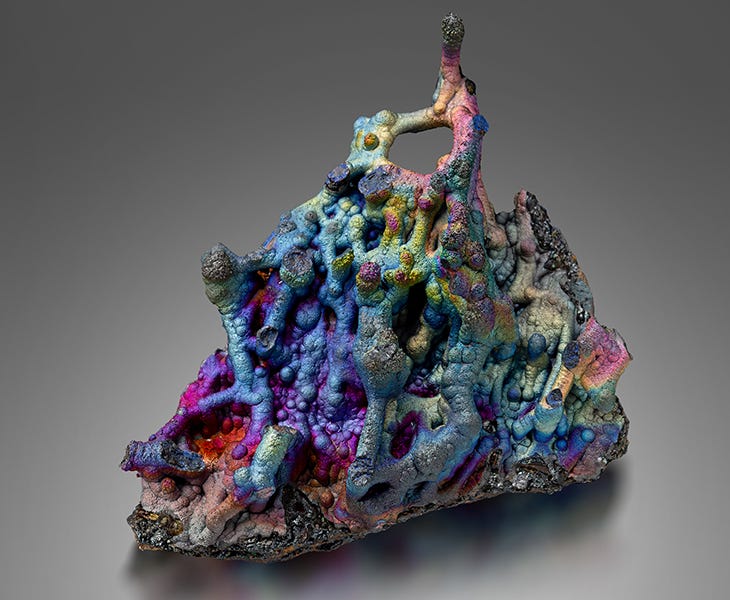
It has been suggested that Turing's belief in fortune-telling may have caused his depressed mood.[180] As a youth, Turing had been told by a fortune-teller that he would be a genius. In mid-May 1954, shortly before his death, Turing again decided to consult a fortune-teller during a day-trip to St Annes-on-Sea with the Greenbaum family.[180] According to the Greenbaums' daughter, Barbara:[172]
But it was a lovely sunny day and Alan was in a cheerful mood and off we went... Then he thought it would be a good idea to go to the Pleasure Beach at Blackpool. We found a fortune-teller's tent and Alan said he'd like to go in[,] so we waited around for him to come back... And this sunny, cheerful visage had shrunk into a pale, shaking, horror-stricken face. Something had happened. We don't know what the fortune-teller said but he obviously was deeply unhappy. I think that was probably the last time we saw him before we heard of his suicide.
"The Chemical Basis of Morphogenesis" is an article that the English mathematician Alan Turing wrote in 1952.[1] It describes how patterns in nature, such as stripes and spirals, can arise naturally from a homogeneous, uniform state. The theory, which can be called a reaction–diffusion theory of morphogenesis, has become a basic model in theoretical biology.[2] Such patterns have come to be known as Turing patterns. For example, it has been postulated that the protein VEGFC can form Turing patterns to govern the formation of lymphatic vessels in the zebrafish embryo.[3]
The Chemical Basis of Morphogenesis - Wikipedia
Does morphogenesis have a chemical basis, though? No one has ever been able to make an organism by mixing chemicals. This is why I shall suggest we should take a rational, levelheaded approach and try to make DNA with lasers instead. This might sound like I took a bunch of random things from different comic books and put them together, but I guarantee you it’s the most rational approach right now even on the off-chance it turns out not to be a correct approach. The fact is, stating that morphogenesis must be due to chemicals because we don’t know how it works is simply the return of black magic, and I suspect the vast majority of scientific research being done today is black magic. I think the first kind of black magic in the sciences was positivism, which can be shown by its very name:
The most important thing to determine was the natural order in which the sciences stand—not how they can be made to stand, but how they must stand, irrespective of the wishes of any one. ... This Comte accomplished by taking as the criterion of the position of each the degree of what he called "positivity," which is simply the degree to which the phenomena can be exactly determined. This, as may be readily seen, is also a measure of their relative complexity, since the exactness of a science is in inverse proportion to its complexity. The degree of exactness or positivity is, moreover, that to which it can be subjected to mathematical demonstration, and therefore mathematics, which is not itself a concrete science, is the general gauge by which the position of every science is to be determined. Generalizing thus, Comte found that there were five great groups of phenomena of equal classificatory value but of successively decreasing positivity. To these he gave the names astronomy, physics, chemistry, biology, and sociology.
— Lester F. Ward, The Outlines of Sociology (1898), [13]
For one, notice that psychology isn’t even there, astronomy is arbitrarily treated as the most precise science for no discernable reason as if it gave rise to the other sciences… One almost gets the impression he is confusing science with magic and astronomy with astrology. Geology, despite being much more relevant to most people’s lives, likewise makes no appearance in his list despite the presence of astronomy and considering it somehow more fundamental than physics. One very much gets the impression Comte was an armchair philosopher who never actually did any science. Mathematics can indeed be applied to every science equally, though I tend to think it gets harder as you ascend the hierarchy, not because it’s ontologically random, but because things which are more complex and more worthwhile take more work as they should. People care a lot more about the workings of brains than the workings of screws, and brains are better than screws anyway, everything about screws can be known by brains, but nothing about brains is really stored by screws.
When categorizing the many disciplines of science that developed during this period, Romantics believed that explanations of various phenomena should be based upon vera causa, which meant that already known causes would produce similar effects elsewhere.[2]: 15 It was also in this way that Romanticism was very anti-reductionist: they did not believe that inorganic sciences were at the top of the hierarchy but at the bottom, with life sciences next and psychology placed even higher.[2]: 19 This hierarchy reflected Romantic ideals of science because the whole organism takes more precedence over inorganic matter, and the intricacies of the human mind take even more precedence since the human intellect was sacred and necessary to understanding nature around it and reuniting with it.
Romanticism in science - Wikipedia
The problem with positivism is right there in the name, positive-ism. It says you can’t be so certain aka positive about more complex things, as opposed to saying they take more work to understand but that its’s worthwhile because brains are a lot more interesting and useful to know about than screws, levers, and pulleys. Also notice Romantics care about psychology and don’t consider sociology legit rather than vice-versa, and astronomy is not mentioned in particular at all while simply forgetting about geology for whatever reason.

I’m not going to try to write a paper about this now, because I think if anything I need to make my way through academia or at least try because I strongly think academia must not suck by necessity even if parts of it suck, all the alternatives are worse even if it’s not the utopia many people have been lead to believe and that really lets them down, but I do think the forms of organisms, like evolution, are just one natural result of negative entropy (negentropy.) If entropy is a loss of order and information, then negentropy is a gain of order and information. There’s no need to try to make up new laws of nature to explain evolution and the origin of life, it’s just the natural result of what life is. Morphogenesis and evolution are just two sides of one coin. Life never evolved from non-life because entropy doesn’t turn into negentropy by black magic, but chemicals did evolve from other forms of negentropy as complexity naturally increased. This is why I unironically think the best experiment that could be done in a lab as “white-coat biology” today would be to try to make DNA with lasers, and not try to make DNA from soup.
I propose that there’s most likely effectively another kind of electromagnetic field even if it’s not necessarily equally fundamental: electrooptic fields or photonic fields. This isn’t a claim there’s an entirely new kind of fundamental stuff any more than saying that sound waves can be analyzed as phonons is saying there’s an entirely new kind of fundamental stuff and we need to add sound particles to the Standard Model along with all the quarks and leptons. It’s not fundamental, but I do think it’s a new analysis that’s meaningful and which I’ve been considering off and on. My analysis has been, due to quantum effects that only exist beyond the classical limits of electromagnetism that are described in Maxwell’s equations, photons can enter a feedback loop through electrooptical effects and in this case the photons themselves act like a field separately from the electric and magnetic fields. I also think this can probably best be analyzed as skyrmions or something else similar like hopfions but more tests need to be done.
Research demonstrates that quantum entanglement and topology are linked | Electro Optics
Non-local skyrmions as topologically resilient quantum entangled states of light | Nature Photonics
Circles Sines and Signals - Sine Wave Properties (jackschaedler.github.io)
Researchers Use Quantum Entanglement To Detect Radio Waves (rfglobalnet.com)
In classical electromagnetism there are limits to how light waves can be propagated, but as soon as there’s entanglement, those limits can be surpassed. The interesting part is, the entanglement happens on a more electronic level, not a level of photons, but photons and electrons are already entangled whenever they’re emitted. So certain patterns of electromagnetism should inherently show quantum mechanical effects and the effects should essentially be a sort of cybernetic feedback loop. Interference is also important since it allows photons to interact (yes, photons do interact via interference contrary to all the people who don’t know better saying they can’t interact because they don’t have mass,) and I think this is also related to the topological idea that is responsible for nonlocality and what Bohm would call the implicate order in his theory, which he didn’t consider to be complete since it explained the data better than anything else but it seemed contrived.
I think this is how morphogenesis occurs, the DNA is necessary but it’s interacting with a pre-existing quantum electromagnetic field to shunt proteins around to where they need to be, not making things solely on a chemical level from scratch and somehow chemistry alone organizes the organism via black magic. This itself violates the idea of positivism because it’s biophysics and biology and physics are not right next to each other on Comte’s positivist ladder, but normal people who haven’t heard about these things to have a bias one way or another don’t care about that and physics journals such as Physical Review X that actively publish 100x as many papers about biophysics as string theory and cosmology certainly don’t. This is also nearly the same way I stated I think brains work. If entanglement happens due to two forces opposing each other then I also think the two hemispheres of the brain and the two strands of DNA and more specifically, the areas between them are the best places to look for entanglement effects and the origin of these fields. I don’t think it’s coincidental that the two main problems in biology probably require slightly different versions of the same physics to solve them, and ideas like memory and transmission are highly involved in both. That means that if brains are flexible metasurface photonic crystals that use magnetic fields for memory and electromagnetic waves for carrying information between neurons like a cable television then low-frequency waves would interfere with brainwaves, though that doesn’t mean any information would necessarily be preserved rather than it just being noise that disrupts processes. I do think wifi etc. are likely not good for your health even at longer distances than what’s officially considered safe though because of that, but that’s speculative and more testing would need to be done.
These are my ideas for the time being, I hope to be able to acquire all the qualifications to publish them through more official channels as soon as possible.




